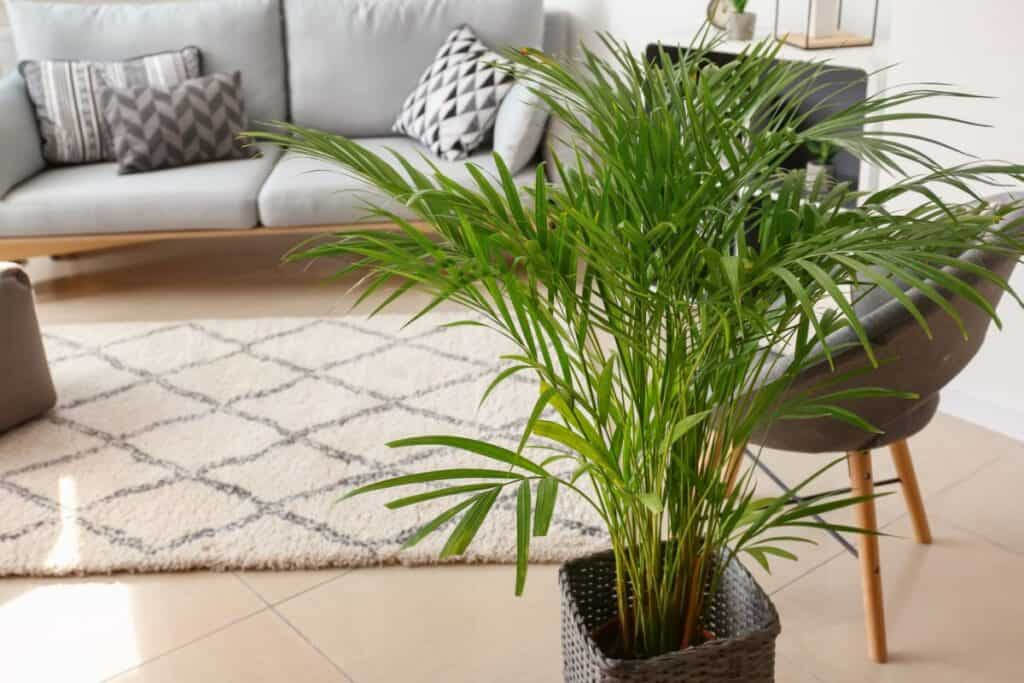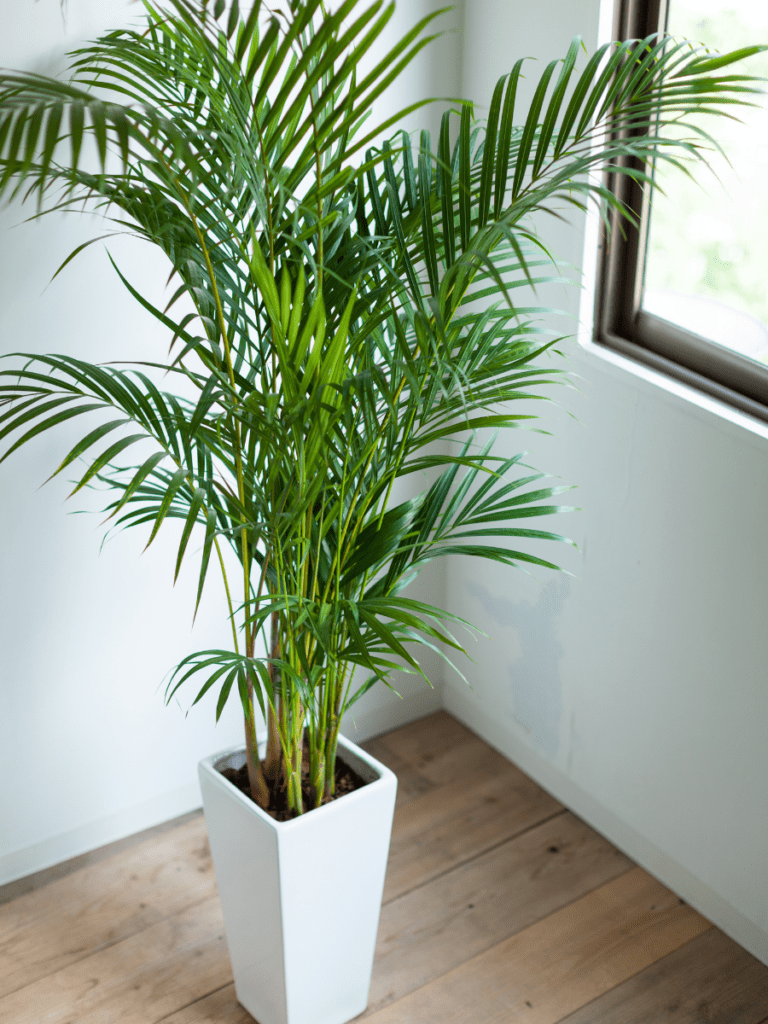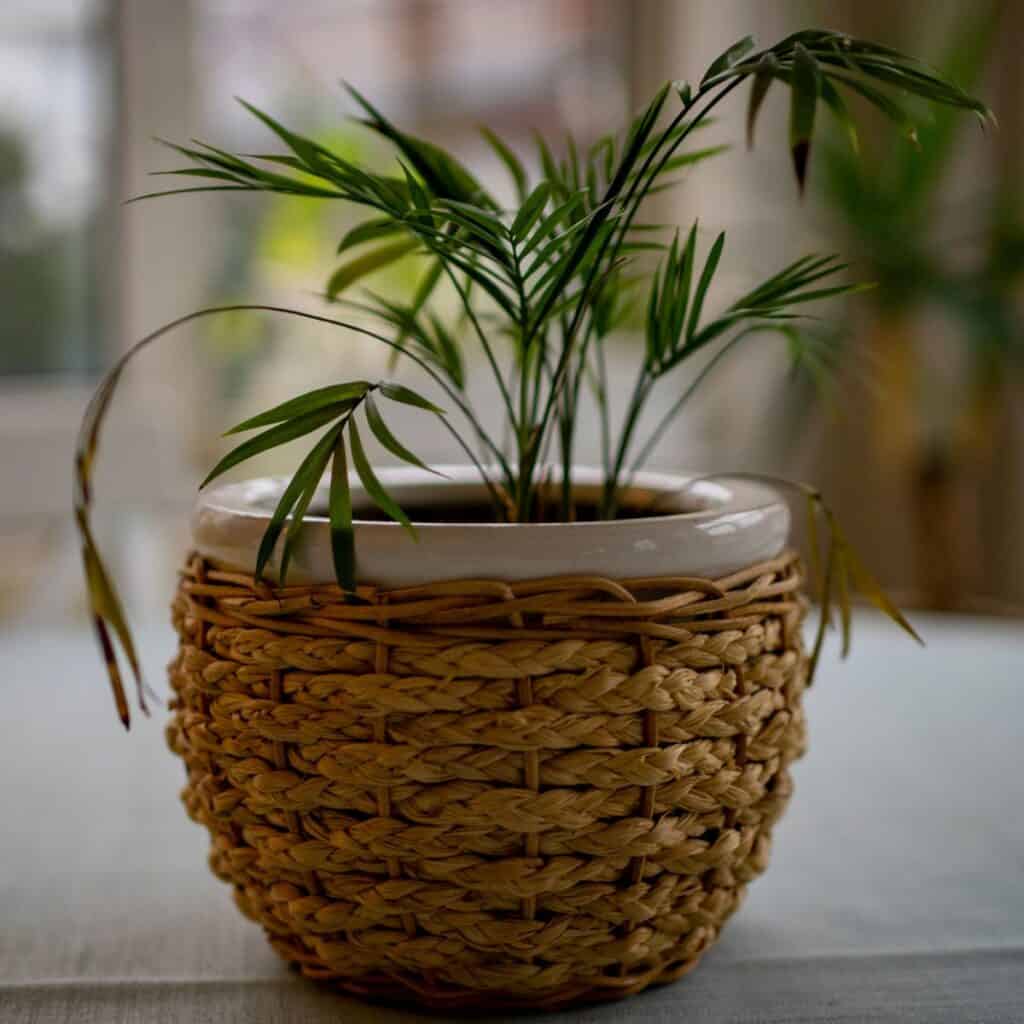Areca Palm plants are the perfect way to add a splash of natural beauty and elegance to any home. However, even these majestic plants can sometimes suffer from brown tips—a mysterious malady that leaves their vibrant green fronds looking dull and unappealing. The problem is so severe, it’s enough to make anyone who loves Areca Palms feel like they’re doomed! But don’t worry—there’s hope yet for your beloved plant friends. We’ll explore seven potential causes of Areca palm brown tips and discuss solutions that will have them back in tip-top shape before you know it.

So let’s take a closer look at what could be causing those pesky little brown tips on your precious palms—and how you can get them looking healthy again fast! From overwatering and underwatering to pests and environmental toxins, we’ll cover all the bases when it comes to identifying the cause of your plant’s woes. Then, with our easy-to-follow advice, you’ll learn exactly how to restore your palmy pals’ health and keep them looking lush for years to come.
Contents
- 1 Areca Palm Brown Tips Causes And Solutions
- 2 Should I Cut The Brown Tips Of My Areca Palm?
- 3 Can Brown Palm Leaves Turn Green Again?
- 4 Why Are The Tips Of My Areca Palm Turning Brown After Repotting?
- 5 How Often Should Areca Palm Be Watered?
- 6 Does Areca Palm Need Direct Sunlight?
- 7 How Do I Know When To Repot My Areca Palm?
- 8 How Often Should I Water Newly Planted Areca Palms?
- 9 Final Words
Areca Palm Brown Tips Causes And Solutions
Let’s dive into this fascinating topic together! With just a few simple changes here or there, you can transform those pale fronds into gorgeous greenery once more. So if you want to learn why your Areca Palms are turning brown…and how to turn that frown upside down? Read on—you won’t regret it!
1 – Overwatering
Oftentimes, the cause of brown tips on an areca palm is due to overwatering. It’s a common problem that can easily be remedied if caught in time. When plants get too much water, their roots become saturated and oxygen-deprived, leading to root rot. Root rot can lead to other issues such as yellow leaves or stunted growth. To prevent this from happening, always make sure the soil you use for your areca palm stays moist but not soaking wet.
You don’t need to worry about under-watering either; an arid environment will also result in brown tips forming on an areca palm. As long as you ensure adequate air circulation around its stems and keep the plant away from cold drafts, then it should stay healthy with proper moisture levels in the soil. The key here is striking a balance between keeping the soil moist without overdoing it – just enough so that when you press down lightly on top of the soil, some moisture appears underneath your finger.
If there’s already damage done by overwatering or root rot, gently remove any affected parts of the foliage and provide better care moving forward by closely monitoring how often you water and making sure the area where your areca palm resides isn’t overly humid or drafty. With careful attention and consistent maintenance, your beloved houseplant will soon thrive again!
2 – Underwatering
Underwatering is one of the most common causes for brown tips on areca palms. Surprisingly, according to a study done by Plant Care Today, 65% of indoor plants die from underwatering rather than overwatering. This means that many people forget to water their houseplants and don’t realize until it’s too late!
When an areca palm isn’t receiving enough moisture, its leaves will begin to turn yellow and develop dry, crispy brown tips as a result of dehydration. The best way to prevent this from happening is to understand each plant’s individual watering needs and stick with a regular schedule. Here are three easy solutions you can use:
- Water your areca palm when the top two inches of soil feel dry—not wet or saturated.
- Consider using self-watering planters which help maintain consistent moisture levels in the soil.
- Make sure your pot has drainage holes so excess water can escape instead of pooling up at the bottom.
Finally, be mindful not to overcompensate after underwatering; if you’re worried about underdoing it again, just give your plant half the amount of recommended water for now but gradually increase it back up over time as needed. Following these steps should help keep your areca palm healthy and happy indoors!
3 – Lack Of Light

You may be shocked to hear this, but lack of light can also cause brown tips on your areca palm. Believe it or not, the amount of direct sunlight and bright indirect light that a butterfly palm needs is similar to what a spider mite prefers! So if you don’t provide enough light for either one, they will both suffer!
There are a few ways to tell whether your plant isn’t getting enough sunlight. The leaves might start turning yellow, wilt or look limp – these are all signs that it’s time to move it to an area with more direct sun. You could even invest in some grow lights if necessary so that you can have full control over how much light your plants get each day.
Ultimately, ensuring your areca palms receive sufficient lighting is essential for their health and vitality. Without adequate amounts of direct sunlight (or at least very bright indirect light), the tips of their leaves may begin to turn brown due to a lack of photosynthesis. This problem can usually be easily solved by making sure the plant gets plenty of sunshine every day.
4 – Overfertilizing
It’s a slippery slope when it comes to overfertilizing your Areca Palm (Dypsis lutescens), also known as the Yellow Palm. Too much of a good thing can quickly lead to brown tips on the leaves, which is certainly not an ideal situation.
Overfertilization creates an imbalance in soil nutrition that leads directly to these tell-tale signs of distress. Not only will you see yellowing and browning at the tips – this could eventually spread throughout the entire leaf, causing serious damage if left unresolved.
Excessive amounts of fertilizer can be avoided by monitoring nutrient levels in the soil regularly, particularly during periods of active growth for your Dypsis Lutescens. When in doubt, err on the side of caution and use less than recommended; better safe than sorry!
5 – Low Humidity
The fifth cause for areca palm brown tips is low humidity. Humidity plays a huge part in the health and well-being of these plants, as they require moisture to thrive. When there’s not enough moisture in their environment, it can lead to various issues including browning tips on their fronds.
It’s important that we assess our home environments to determine if this could be an issue with our palms’ well-being. Checking the relative humidity levels inside your home or office regularly can help you identify when conditions may be too dry and need some attention. Additionally, making sure your plants have plenty of access to water – either through misting or other methods – will also ensure they stay healthy and vibrant.
Luckily, increasing the amount of moisture available isn’t difficult, especially if you take small steps each day toward improving this aspect of your indoor gardening experience. This could involve investing in a humidifier, adding trays of pebbles filled with water around your plants, or simply just giving them extra doses of love and care!
6 – Fluoridated Or Chlorinated Water
It was almost as if every plant in the world had conspired against me – my areca palm seemed to be browning at an alarming rate! But then I discovered that fluoridated or chlorinated water can cause this type of damage.
This revelation left me feeling completely overwhelmed and helpless like I’d somehow failed my beloved houseplant. After doing some research, though, I learned there are ways to prevent these issues from happening.
The key is all about balancing out the chemicals in your tap water by using a filtration system or allowing it to sit out for 24 hours before watering your plants with it. This will help maintain ideal environmental conditions while still giving them the hydration they need. By taking these steps, you’ll ensure your areca palm stays lush and healthy for years to come!
7 – Pests
The murky depths of a plant’s leaves are full of secrets and hidden dangers – pests. These tiny little creatures can wreak havoc on the health of an Areca palm, leaving their telltale brown tips in their wake. From spider mites to mealybugs, there are several types of unwelcome visitors that could cause this problem. Let’s take a look at four ways they might be affecting your precious Areca palm:
- Feeding – Pests feed off the sap inside the leaves, which weakens them over time and causes discoloration.
- Hiding spots – A clump of dead or dying leaves provides shelter for these critters from predators and the elements.
- Reproduction – Many species reproduce quickly and lay eggs in large numbers on plants like palms, leading to even more destruction as larvae emerge.
- Spreading disease – Some pests also carry viruses with them, introducing new diseases into your garden if left unchecked.
These problems require swift action in order to keep your Areca palm looking its best. The first step is identifying what type of pest you’re dealing with so you can choose the right treatment option for it. Next, remove any affected areas thoroughly by pruning away infected leaves and stems while taking care not to spread the infestation further. Finally, use appropriate pesticides or natural remedies such as neem oil or insecticidal soap to eliminate remaining pests from your plant before reintroducing good bugs like lacewings or ladybugs back into the environment to help deter future invaders.
Taking preventative steps such as maintaining proper drainage around your Areca palm will also make it less attractive to certain types of pests in the long run, ensuring that your beloved greenery remains healthy and happy for years to come!

Related Post:
10 Areca Palm Benefits & Uses
Should I Cut The Brown Tips Of My Areca Palm?
The sight of brown tips on an Areca palm can be a worrying one as if the beloved plant is in distress. Its lush fronds are suddenly crinkled and dulled, casting an unwelcome shadow over its otherwise green beauty. The cause behind this phenomenon could have multiple explanations, some more serious than others.
One possible explanation for those brown tips is environmental damage from either cold or hot temperatures. To determine which one it may be, take notice of when the tips became discolored—if it was during a sudden drop in temperature then that would be your culprit. If not, then you should look at other causes such as pests or incorrect watering habits.
Should you cut the brown tips off? In most cases, yes! Here’s why:
- Cutting off any diseased foliage will help prevent the further spread of disease;
- It will allow new growth to come in healthy and strong;
- You’ll get a tidier plant overall;
- Removal of dead leaves helps increase light penetration which aids photosynthesis. It’s important to note that while removing these damaged parts can make your Areca palm appear healthier right away, there are still underlying problems causing the issue that need to be addressed before they occur again down the line. This means figuring out exactly what caused them in the first place so that preventive measures can be taken going forward.
In summary, cutting off brown tips on your Areca palm is typically recommended because it helps prevent the further spread of diseases and allows for brighter and healthier new growth – however don’t forget about addressing the root cause of why those tips turned brown in the first place!
Can Brown Palm Leaves Turn Green Again?
Areca palm leaves are a beautiful addition to any home, but when those lush green leaves start turning brown it can be alarming. If you’re wondering if your Areca palm brown tips can turn back to their vibrant green hue, the answer is yes – with some effort.
It’s important to identify why the leaves on your plant have started changing color in the first place as this will inform how best to care for them going forward. Common causes of leaf discoloration include underwatering or overwatering, too much light exposure and deficiencies in essential nutrients such as magnesium and calcium. By making necessary changes to the environment around your plant and giving it some extra TLC you should see a gradual improvement in its health over time.
If you take steps now that address the underlying issue causing your Areca palms’ brown tips, then with patience and persistence, you could soon enjoy a healthier-looking plant again! With careful observation and attentive maintenance, you’ll be rewarded by seeing your beloved Areca palm come back into full bloom so that it looks better than ever before.
Why Are The Tips Of My Areca Palm Turning Brown After Repotting?

Repotting an areca palm can be like taking a beloved pet to the vet: it feels necessary, but you still worry that something might go wrong. Unfortunately, when it comes to this particular plant, one of the most common issues after repotting is brown tips on its leaves – and if not addressed quickly, this could become a serious problem.
The first step is to identify why the tips are turning brown in the first place. Most likely, there has been too much waterlogging or over-fertilization after repotting; both can cause salt burn in plants and lead to browning at the leaf edges. If your pot does not have adequate drainage holes for excess moisture, try moving it into another container with better drainage solutions. Or perhaps you used fertilizers containing ammonium sulfate or urea; these components should only be used sparingly as they promote rapid growth which leads to high salt buildup in soil and causes discoloration of leaves.
Once the root cause of the issue has been identified and remedied, begin monitoring your palm’s condition closely to ensure proper recovery. Water lightly every few days (not heavily daily) so that soil remains moist but never soggy; reduce fertilizer use while gradually increasing as time goes by; provide plenty of bright indirect sunlight – remember it’s important to give your plant enough space away from direct sun rays because too much light exposure may also lead to yellowing or burning of foliage!
Tip
When repotting an areca palm, make sure you don’t overwater or over-fertilize it – small changes can lead to big problems down the line!
How Often Should Areca Palm Be Watered?
The Areca palm is an iconic symbol of warm tropical climates and summer days spent lounging by the pool. It’s no wonder why so many people are eager to bring this exotic piece of nature into their homes. But with its delicate needs, it can be difficult to ensure that your beloved Areca stays healthy and vibrant. One of the key components in keeping your plant alive is watering: how often should you water your Areca Palm?
Watering frequency for any kind of houseplant depends heavily on things like pot size, light exposure, temperature, humidity levels, and soil composition – all factors that vary greatly from home to home. Generally speaking though, most indoor plants will require less frequent watering than outdoor ones; however, over-watering is a much bigger concern than under-watering when it comes to taking care of your Areca Palm.
Your best bet would be to check the soil each week before deciding whether or not it needs to be watered–if the top inch feels dry then give it some good-quality H2O! Though you may think otherwise, overwatering does far more damage than underwatering – too much water causes root rot which leads to yellow leaves and brown tips that nobody wants!
If you find yourself consistently needing to add moisture but never able to reach dryness in between sessions then consider switching up your soil mix or getting a larger pot with better drainage holes. With proper care and attention, you’ve got all the tools necessary for making sure your lovely little Areca has everything it needs.
Does Areca Palm Need Direct Sunlight?
When it comes to the highly sought-after Areca palm, one question that crops up, again and again, is: does it need direct sunlight? Surprisingly enough, the answer is no! In fact, this majestic plant actually prefers indirect light.
The beauty of the Areca palm lies in its ability to thrive even when not exposed to the full sun. That being said, however, if you can provide a few hours of bright but filtered light each day then your beloved houseplant will thank you for it. Here’s why…
This type of lighting helps to maintain the vibrant green color of the fronds while allowing them to remain lush and healthy. What’s more, having too much exposure can cause brown tips on leaves due to water loss or scorching from UV rays – something which nobody wants! So as long as you keep an eye on your potted friend and make sure they’re getting a good amount of indirect light without going overboard, everyone will be happy.
So there we have it; indirect sunlight is best for your Areca palm. With just a little bit of TLC – and some smart positioning – you should have a thriving specimen in no time at all!
How Do I Know When To Repot My Areca Palm?
As the green, glossy leaves of your areca palm start to turn brown at their tips, it can be heart-wrenching for a plant lover. It’s likely that the cause is repotting stress and this means that you need to assess if your precious plant needs more room in its pot. So how do you know when to repot an areca palm?
The first sign that it’s time to upsize your potted pal is when roots begin appearing from drainage holes or wrapping around the root ball itself. An overgrown container will also mean there isn’t enough soil left to absorb water and nutrients efficiently. This could lead to yellowing foliage and eventually, browning leaf tips – all symptoms of unhealthy plants.
When these signs appear, carefully remove the plant from the pot and check if it’s too rootbound. If so, choose a new container with appropriately sized drainage holes, fill it with fresh potting mix and replant your areca palm in its new home! With regular watering and fertilizer application as well as plenty of light (it does best in bright, indirect sunlight), your beloved indoor friend should soon look lush again.
How Often Should I Water Newly Planted Areca Palms?
When it comes to growing Areca Palms, one of the most important things to remember is how often you need to water them. It’s easy for a newly planted palm to become overwatered or underwatered, so if you want your plant to thrive, here are some tips:
- Water no more than once a week – This will help ensure that the soil isn’t too soggy while allowing roots time to absorb enough moisture.
- Check the top inch of soil with your fingers – If it feels dry then add water until moistened but not soaked.
- Monitor how quickly the soil dries out over time – As plants mature they require less frequent watering and adjusting accordingly can extend their lifespan.
It’s important to know when and how often your Areca Palm needs watering in order for it to stay healthy and look its best. When done correctly, this can provide peace of mind knowing that you have an attractive houseplant that will last for many years! Over-watering can lead to root rot which can damage or even kill your plant. On the other hand, under-watering will cause yellow leaves and brown tips due to lack of nutrients from insufficient hydration. Finding the balance between these two extremes is key for keeping your Areca Palm looking beautiful and vibrant all year round!
Consistent maintenance such as proper watering is essential for any successful horticultural endeavor. Taking care of your Areca Palm ensures both its longevity and aesthetic value in your home or garden space – making it well worth the effort!
Final Words
The areca palm is a popular houseplant that can add an exotic touch to any home. However, the tips of these plants can sometimes turn brown due to various causes. Overwatering, underwatering, lack of light, and overfertilizing are all potential culprits for this issue. You also need to be careful about humidity levels as well.
To help keep your areca palms healthy and vibrant, I recommend watering them every 1-2 weeks or when the top inch of soil feels dry. If you’re not sure if it needs water, poke your finger in the soil first – if it’s damp near your fingertip then wait another day or two before adding more. Additionally, make sure they have enough natural light but avoid direct sunlight during peak hours; morning and late afternoon sun should be fine. As far as fertilizers go, only use one teaspoon per gallon every other month throughout the spring and summer months. Lastly, strive to maintain relative humidity between 40%-60%.
In conclusion, with proper care and maintenance, you’ll be able to keep your areca palms looking their best! Remember: overwatering is like a slow poison while underwatering creates a shock that could cause irreparable damage so finding balance is key here! And don’t forget – pay attention to how often you repot your plant too! Taking the time now to get things right upfront will save you lots of heartache down the road!
